eISSN: 2469-2794


Research Article Volume 11 Issue 4
Professor Master of Gender, Department of Social Sciences, National University of Luján, Argentina
Correspondence: Mariano Sergio Ramos, Professor Master of Historical Archeology Faculty of Philosophy and Letters, University of Buenos Aires, Professor Master of Gender, Department of Social Sciences, National University of Luján, Member of Center for Historical Archeology Studies, Faculty of Humanities and Arts, National University of Rosario, Argentina
Received: November 22, 2023 | Published: December 18, 2023
Citation: Ramos MS. Return to the crime scene. paradigms and research. Forensic Res Criminol Int J. 2023;11(4):164-172. DOI: 10.15406/frcij.2023.11.00388
This paper deals with some research procedures, considering the author's experiences in the field of Archeology and Epistemology. It refers to what I consider to be the beginning of scientific studies, related to the research process in various fields of knowledge, in particular, in Archaeology. During the first decades of the 19th century, the foundations of Logical Positivism were laid out, which influenced the development of greater rigor in research procedures, especially during the second half of that century. Thus I will consider aspects of the indexical paradigm in a little more detail and will only make a reference to the so-called positivist criminology and the etiological paradigm of criminality. On the other hand, to illustrate some research procedures, I will consider some case studies in Archeology such as those developed at the site that was a battlefield in 1845 in the town of Vuelta de Obligado, Province of Buenos Aires, Argentina.
Keywords: indiciary paradigm, investigation procedures at the vuelta de obligado site, crime scene, problems to be solved, three cases
Intelligence is the basis of knowledge; Science builds it and is nourished by knowledge, also by imagination and creativity to solve problems or simply provide answers to questions. Human beings are characterized by their capacity for inventiveness and concern for asking themselves many questions that do not manifest themselves clearly in the first instance. Thus he stands out for his desire to know aspects of the reality of the present as well as the past. It is agreed that knowledge of this reality is the responsibility of science. But, originally science is an invention of the so-called Western World of a certain period and, as such and in context, it is presented with an important and almost insurmountable cultural bias. According to Ernest Nage1 science, in general, is the systematic and controlled knowledge of reality. It is based on a coherent set of knowledge related to certain categories of facts, objects or phenomena and includes an activity that attempts to gather, organize and systematize this knowledge. This knowledge is taken as rationally coherent, verifiable and refutable and attempts to describe - for some - the laws of Nature and thought; also the structures and processes of cultural and social organization.
For logical positivists, science can be analyzed as a discourse or language that is logically organized and subject to empirical verification. This is a path very usually followed by natural science researchers; however, many archaeologists - and some historians - took it, even in part, and tried to follow their procedures for several decades. On the other hand, for Marxists, science would be the knowledge that describes the laws of Nature and History.2,3 Issues linked to the knowledge of reality, such as ideas and concepts of science, all contain particular philosophical perspectives.1
Epistemology or Philosophy of science is responsible for analyzing and reviewing the procedures used to generate knowledge. This discipline studies the conditions of production and validation of scientific knowledge and, in particular, deals with scientific theories. Currently some “post-moderns” question even the existence and value of Epistemology; however, it continues standing. On the other hand, the sciences that are attributed with knowledge of humanity's past, mainly Archeology and History, are two disciplines built with the scientific requirements of the time starting in the 19th century. Archaeologists and historians try to know the past of humanity. However, it is not so easy for us, archaeologists, to use and justify the means that allow us to know this supposed past:
“But, without a doubt, the series of mediations that exist between the observer's knowledge of contemporary and simultaneous phenomena is less than that faced by someone who tries to know something whose dynamics occurred in another time, and of which we only observe static and partial, with different degrees of distortion in relation to their original characteristics. That is why perhaps archaeologists have always had an interest (overt or veiled) in the questions of how it is produced and how reliable our knowledge is as a whole. Interest in epistemological problems is, therefore, a constant concern in our discipline.”4
Regarding knowledge of the past, professionals in the exact and natural sciences, in general, operate with certain prejudices and arguments against the objectivity of that knowledge. So, faced with the attempt to know past events and processes, those maintain that this past is: a. unobservable and, therefore, b. unknowable. This reasoning is based on two prejudices related to sciences that are based on laboratory experiments: 1. there is no direct witness of that past and if there is one in some science, this is valid and privileged and 2. observation would exhaust knowledge since the sciences that observe can account for what happens.2,3,5 We archaeologists know that our source of information, the materiality found in an archaeological site, is a contemporary phenomenon.6 It is something that is here and now, in this present, but it is static, as if it were a photograph. We archaeologists try to interpret or explain these material residues that correspond, briefly, to certain activities and interactions that involved human beings and also their ancestors. Those people are no longer there, they left those objects or fragments of them and we have to see how they interacted with that materiality. In terms of archaeologist Lewis Binford “…if we try to investigate the relationship between statics and dynamics, we must be able to observe both aspects simultaneously; and the only place where we can observe the dynamics is in the current world, here and now.”6 That is, we need certain theoretical instruments that give meaning, in the context of the past, to those elements found; however, the archaeological record is not sufficient. Archaeologists would have to overcome that abyss (Figure 1) that separates the world from the objects, residues and other evidence found in excavations, and project ourselves towards our objective of interpreting or explaining the events and processes of the past, the cultural dynamics, the ways of life, social activities, etc.,7 according to where each one is located theoretically.
In the book In Pursuit of the Past,6 Binford proposed three possibilities that would allow for fine-tuning inference methods in archaeological research. This is what he considered at that time:
Well, these three ways allow us to evaluate and refine the inference procedures since not one, but more than one source of information is used, for example in the case of historical archaeology, the archaeological record and written documents, which allows us to compare the data obtained by each of them. During the 19th century, and on the basis of certain positivist postulates, attempts were made to generate paradigms linked to the study of traces or traces that manifest as a consequence of certain somatic traits; also others linked to certain human behaviors. We are going to cite only two of these paradigms, but we will give prominence to one of them, which can be a reference for archaeological investigations.
Paradigms. An attempt failed by Paradigms
During the last quarter of the 19th century, and inspired by scientific Positivism, a line of research was formed that attempted to be shown as a criminological paradigm. This line had a pathological conception of crime and the criminal, its main actor. Thus, a crime was considered an anomalous event and its author an abnormal being, who had to be reformed and re-educated.10 Several researchers, mainly Italian, stood out in this current: Césare Lombroso; Enrico Ferri and Rafaele Garófalo. To such a point came the conviction of those researchers who considered their postulates as the body of a new science, Criminology, as the scientific discipline of the study of the causes of so-called criminal behavior and derived from it, the etiological paradigm of criminality. Based on these conceptions, Lombroso gave prominence to various components of a biological nature and, above all, hereditary nature. In the case of Garófalo, he emphasized the role of the psychological elements of the individual; and, finally, Ferri relied on the influence of sociological factors.10 This current or school was based on certain philosophical assumptions and fundamental postulates that were the following: “1. Crime is conceived as a natural entity given in advance to social experience and the institutional reaction of the penal system, as an essential and intrinsic quality of certain ('criminal') behaviors; 2. Hence, crime constitutes for this current of criminological thought a kind of natural entity - at the time the expression 'natural crimes' became common -; 3. in the context of positivist ideology, and in opposition to the postulates of the classical school (which saw crime as the product of the free will of the subject contrary to the norm), the etiological paradigm of criminality postulates a rigid determinism (biological, psychological, sociological) so that the mere presence in the person of the alleged 'factors' of criminality would lead, without further ado, to the emergence of criminal behavior, or at least the danger of it occurring."10 The supposed etiological paradigm of crime was built on the basis of observation and analysis of people selected by the penal system. Thus, the subjects were previously chosen and studied clinically with the aim of developing the theory of the causes of crime. These individuals were trapped in the judicial and administrative system of criminal justice. They were “clients of the prison and the judicial asylum.”10
Baratta analyzes the social mechanism of the selection of the criminalized population, which “…should, by a mysterious pre-established harmony, coincide with a biological selection.”11 There was an error in method since these studies, supposedly “scientific”, had as their object of analysis people previously selected by the penal system. That sample had, in the view of these researchers, specific natural characters and causes, “as if the social mechanism of selection of the criminalized population should, by a mysterious pre-established harmony, coincide with a biological selection.”10 It is understood that this way of proceeding with respect to the study of the criminal phenomenon is not innocent since the clinical observation on the sample of individuals who are the object of knowledge that will allow new forms of social control.10 Suárez says:
“Edwin Sutherland rightly criticized theories of criminal behavior such as these, based on economic, psychopathological and/or sociopathological conditions to explain criminal behavior, by maintaining that they are not valid as unitary explanations of criminality because they cannot account for a considerable proportion of criminal behavior, which is white collar crime... are a more than clear expression of the dominant ideology in this field of knowledge, by conceiving and denouncing as the only crimes - and as the only criminals - those committed by people belonging to the poor sectors.”10 Consequently, this alleged criminological paradigm failed as such according to: 1. an erroneous selection of the sample under analysis composed of individuals already criminalized by the penal system and 2. the support of weak theories whose arguments were based on a dominant ideology that had certain connections, from the anthropological point of view, with the unilineal evolutionary School of the 19th century and its conceptions of higher and lower societies or cultures, with a similar view towards the components of the same society divided into upper, middle and lower classes. Thus, the “criminological paradigm” was forgotten.
The “Paradigma indiziario”
Also, during the 1870s, when the failed construction of the crime paradigm began, a new way of investigating was consolidated in Europe, in an unthinkable and unforeseen manner, which, with the passage of time, the historian Carlo Ginzburg called Paradigma indiziario.12 Agamben also mentions Ginzburg's discovery and emphasizes the use of the most diverse knowledge and techniques included within that paradigm.13,14 During those years, Positivism was not far from the theoretical influences of this new construction. Three men were his inspirations: the art historian Giovanni Morelli (Iván Lermolieff); Sigmund Freud with his psychoanalytic theory and the interpretation of dreams and the writer Arthur Conan Doyle through his characters, especially Sherlock Holmes, a chemist and specialist in anatomy, and Watson, his medical assistant surgeon.14,15 About one of the mentors of the new evidence-based paradigm, Ginzburg says:
“Museums, Morelli maintained, are filled with inaccurately attributed paintings. But returning each painting to its true author is difficult: very often you have to deal with unsigned works, sometimes repainted, or in poor condition. In such a situation, it is essential to be able to distinguish the originals from the copies.”16 Morelli observed, when he visited rooms like museum warehouses, that there were two works that seemed to be the same. Evidently one of them was the original and the other was a fake. Thus, he develops a procedure, based on the search for details, that allows him to search for and classify certain indications that seem insignificant – clues – and that are found in the paintings. They are details that are not observed as central, but rather appear as marginal. The method of analyzing paintings developed by Morelli was based on knowledge he had acquired while studying at the University of Munich. For several years he made several trips to European capitals and Italian cities where he visited private collections and museums that allowed him to complete his artistic training and refine his analytical vision. During these tours he came into contact with many 19th century intellectuals with whom he exchanged ideas and experiences. Morelli's method perhaps began when he was studying the works of Botticelli, and there he noticed that both the ears and hands of the people represented were painted in a similar way.2 This is how he understands that each painter conceived a certain way of representing an ear, a hand, a nail, an eye... Each artist did this in his works in an almost identical, peculiar and different way from that of the others. The conceived method, based on the application of the criterion Comparative method to analyze certain forms, allowed the works to be attributed to a specific artist and to distinguish, and then separate, the original works from the forgeries. Morelli is the one who will introduce the figure of the “connoisseur”, the expert or connoisseur in art; it was. His method can be called “attributionist”, with ancient roots in the world of Greek Philosophy3. Since then, it represents one of the greatest advances in the historiography of art. In the case of paintings, there are certain spaces that are outside the contemplation, detail and control of the author and that are those areas in which the style of each artist can be most recognized. Even for Morelli, the work is more important than the author and he emphasizes that the artist's style should not be sought in what the author controls, but in what he would seem not to control.
Another of the characters who will shape this paradigm of clues will be Sigmund Freud. Ginzburg says that when Freud, in 1914, analyzed Michelangelo's Moses, he made an important reflection about the method developed by Morelli and its relations with psychoanalysis:
“Long before I could have heard of psychoanalysis, I learned that an art expert, the Russian Ivan Lermlieff, whose first essays were published in German between 1874 and 1876, had caused a revolution in the art galleries of Europe, returning to discuss the attribution of many paintings to different painters, teaching to safely distinguish between imitations and originals, and building new artistic individualities from works that had been freed from previous attributions. He had achieved this result by ignoring the general impression and the fundamental features of the work, emphasizing instead the characteristic importance of secondary details, of insignificant peculiarities, such as the conformation of the nails, the ear lobes, the halo of the saints and other elements that usually go unnoticed, and that the copyist does not take care to imitate, while each artist creates them in a way that is his own. Later, it was very interesting for me to find out that an Italian doctor named Morelli was hiding behind the Russian pseudonym... I believe that his method is closely related to the technique of medical psychoanalysis. It is also capable of penetrating secret and hidden things based on little appreciated or unnoticed elements, detritus or 'waste' of our observation..."16 Freud conducts research to seek explanations in the world of dreams. The dream reveals a story. What does that story respond to? Freud started from the presumption by which dreams originate from “…internal conflicts between unconscious desires and the prohibitions that act against them and that we learn from society. Thus, all dreams would be unsatisfied desires whose content seems symbolically disguised. The content of the dream is transformed into the manifest content (the argument) that must be explained to supposedly reveal the person's unconscious desires. Dreams are metaphors or symbolic elements of our real feelings.”17 For his part, another mentor of the new paradigm will be Arthur Conan Doyle, who expresses himself indirectly through the character of Sherlock Holmes. For example, in A Study in Scarlet, Holmes defines himself as fond of observation and deduction, through his profession as a consulting detective of other detectives.18 “The deductive rules set forth by me in the article that has just aroused your disdain provide me with an inestimable service. In my case, the ability to observe is second nature. You seemed surprised when, as soon as I met him, I noted that he had been in Afghanistan.
– Someone told him, no doubt.
– I was not at all aware of his origins in Afghanistan. The well-established habit gives thoughts such a rapid and fluid continuity that I found myself I was headed towards the conclusion without the intermediate steps even becoming apparent to me. These, however, had their due place. Here they are put in order: 'There is in front of me an individual who looks like a doctor and a soldier at the same time. Then, it is a military doctor. She has just arrived from the tropics, because her facial complexion is dark and that is not her natural color, as can be seen from the skin of her wrists. According to what his haggard man proclaims, he has experienced suffering and illness. His left arm has been injured. He keeps it upright and in a forced manner... Where in the tropics is it possible that a military doctor has suffered such setbacks, ¿also receiving a wound in the arm? Obviously in Afghanistan. This concatenation of thoughts did not last the space of a second. I then noticed that it came from the Afghan area, and your mouth was open.”18
As time goes by, the content of Conan Doyle's works, but above all his deductive logic, will serve as inspiration for certain institutions such as the scientific police. The method of searching and interpreting clues generated by Morelli, Freud and Conan Doyle was based on medical symptoms for the diagnosis of diseases. All three had academic training in medicine; however, none of them played the role of doctor, but they worked researching through deduction without looking for general laws of human behavior. They looked for certain clues that generated unique individuals, people who committed crimes15 or, in the case of Freud, patients who gave certain versions of events about which the psychoanalyst had to evaluate and look for other clues to get closer to the true facts. That is to say, they are three doctors who do not practice medicine, but rather use aspects of medical symptomatology to act as detectives, of facts and of people. Currently, as Ginzburg has said, we can consider that the Indexical Paradigm is an epistemological model intended for research in the social sciences. The researcher looks for details and other minimal clues – many involuntary – and then, in context, tries to interpret a given situation based on those details. “Ginzburg reconstructs an epistemological paradigm that, to distinguish it from the model of Galilean science, he defines as 'indiciary', and that has to do with eminently qualitative disciplines, which have as their object cases, situations and individual documents as individual, and precisely because this leads to results that have a non-eliminable margin of randomness.”13 These are the signs that can be revealing within an investigation process.
A century later: ´pluridisciplinarias` research and the evidence
From the second half of the 19th century to the beginning of the 20th century, researchers built and defined, according to personal or group research interests, the different disciplinary fields. Its limits and scope were arbitrary. This construction seemed to delimit watertight compartments in the style of rooms separated by party walls.3,19,20 Each specialist or group of specialists took charge of a place, a particular disciplinary area and thus, when the topic or problem was located very clearly within that area, there were no conflicts and everything that was located there was an entity of the study of that disciplinary space. However, when the problem was located in neighboring areas, several disciplines could provide information about the response sought. Thus conflicts of incumbency and controversies arose over the veracity, reliability and authenticity of the data obtained by some discipline when they were questioned by others that could also provide information on the same problem. As an alternative to this situation of tensions and relations of force, during the last decades of the 20th century, options were defined, conceptually and epistemologically, that, aimed at solving these problems, proposed multidisciplinary relations:21 multi, inter and transdisciplinarity.22 This is how we consider:
“Multidisciplinary is characterized by the joint work of scientists from different sciences around problem solving, without modifying the concepts and procedures of each of them. Interdisciplinary work, on the other hand, is characterized by the exchange of information and procedures, but maintaining the categories of each science. Transdisciplinary work requires the creation of new categories and procedures, which go beyond the contributions made by each discipline.”22 These possibilities always refer to the treatment or resolution of problems; and, in this case, shared problems through pluridisciplinarias4 Relationships9 that encompass those three possibilities that Gianella states. However, there have been some conflicts of an epistemological nature when it comes to sharing a research problem by specialists with different academic training. These conflicts of disciplinary incumbencies and responsibilities have their origin and anchoring in the arbitrary divisions made regarding the field of knowledge and their roots can be traced in the history of science.2,3,19,20 Also, I consider that these questions cover epistemological, ontological and logical aspects. Well, let's go then to specific cases based on evidence that can intervene in multidisciplinary investigations.
The archaeological site of Vuelta de Obligado and three research problems
In this paper I present three cases of investigation of an archaeological site that was a battlefield of the 19th century. This is the war that took place between 1845 and 1846, which pitted the Argentine Confederation against the alliance of England and France. The causes of this conflict are basically geopolitical and economic. The war included the blockade of the ports of the Río de la Plata and battles such as those of Vuelta de Obligado and Tonelero in the Province of Buenos Aires and San Lorenzo and Punta Quebracho in the Province of Santa Fe; in addition to skirmishes and other minor events.
The battle of Vuelta de Obligado occurred on November 20, 1845, 18 km north of the city of San Pedro, Province of Buenos Aires, Argentina. The archaeological site was made up of several military structures such as the batteries (sets of cannons with all their elements and artillerymen), ammunition depots, entrenchment areas, the Argentine camp, the field hospital and the area where the chains were located that formed the shortcut line over the Paraná River. The four batteries of Vuelta de Obligado were arranged on the right bank of the river with an approximate south-north orientation. They were called Restaurador Rosas, commanded by Álvaro de Alzogaray, Almirante Brown, led by Eduardo Brown, son of Admiral Guillermo Brown (Chief of the Argentine naval squadron), General Mansilla, commanded by Felipe Palacios and Manuelita, led by Juan Thorne.23–25 From the beginning of the field activities we worked on the site in the places where we assumed the first and second batteries were located, arranged on ravines more than 10 m high. The third battery was flush, that is, almost at water level, and was located, according to written information, on the beach that forms a bay. There, due to the intense activity of the river that always removes the sediment and the low visibility produced by the vegetation, we were only able to obtain some fragments of European bombs. The fourth battery was located further north, on a ravine about 15 m high where the Torres family house is currently located. The place, very strategic since it allows the observation of a wide extension of the Paraná River, would have served the Chief of the defenses, General Lucio Mansilla, to spot the movements of the European ships and direct the battle. Currently, that place is greatly modified by human activity after the battle since it has solid houses, sidewalks, slopes with stairs and patios.
To locate the archaeological contexts of the site we use: 1. detection instruments such as metal detectors, electro-magnetometers, radar and side-scan sonar; 2. visual prospecting on land and beaches; 3. analysis of plans, aerial photos and satellite images; 4. surface observation and collection; 5. excavations and surveys.9,23,25–31 To date, some 500 m² have been excavated and archaeologically probed, some 10,000 objects have been found, and some laboratory studies (analysis of metal objects, 14C dating, identification of plant species in burned wood) and even lines of experimental Archeology are developed (trampling and kicking tracks, thermoalteration of bones).
Our research began in the year 2000 within what is theoretically known as Historical Archeology21,32 then we approached the general frameworks of the Archeology of Violence33 and the Archeology of Conflict.25,34,35 From the beginning, the study was promoted by the Programa de Arqueología Histórica y Estudios Pluridisciplinarios del Departmento de Ciencias Sociales of the Universidad Nacional de Luján and had the support of professionals from the Facultad de Humanidades y Artes of the Universidad Nacional de Rosario. Within the research team, archaeologists, historians, anthropologists and other specialists from several Argentine national universities, CONICET and foreign archaeologists participated, and participate. Although there are numerous presentations at conferences and events in the speciality, with a correlation of several dozen published papers, here we limit ourselves to explaining a certain research procedure, based on certain indications detected through different sources of information. The data obtained represent convergent information, are confronted with each other and aim to obtain a more comprehensive response to what happened in the past.32
In a relatively recent paper, an American historian, when analyzing what happened during and after the battle of Little Bighorn, states that “Therefore, the battlefield should be considered as a crime scene, and all the original evidence should remain as undisturbed as possible. Only by taking these issues into account can researchers be completely sure of the significance of any object found on the battlefield.”36 Well, let's try to analyze three cases at the ´crime scene`.
Case 1
Problems to solve: ¿how were the defenses mounted in the second battery area? ¿Is it possible to locate signs of those structures?
Sources of information: 1. archaeological record, 2. written documents and 3. Representations or visual arts. Figure 2 summarizes this information (Figure 3, Figure 4, Figure 5).
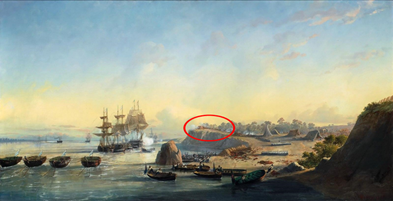
Figure 3 “Attaque et prize des batteries de Ponto Obligado. November 20, 1845”. Engraving by Chavane (1847). The red oval indicates the position of the second battery.
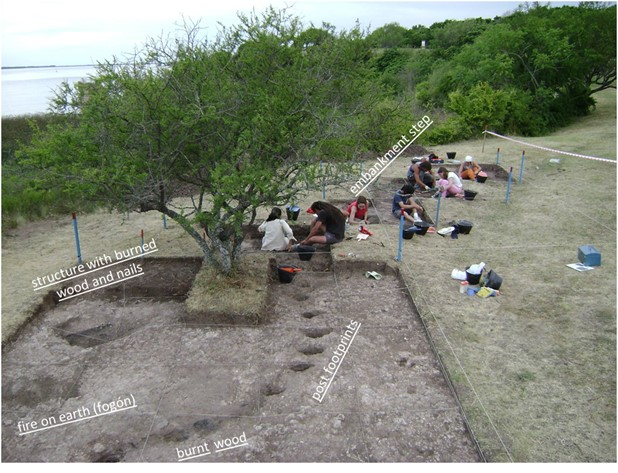
Figure 5 Top left, engraving by Chavane based on a drawing of Barry and the second battery area. Finds in the excavation area of the second battery. Findings: fire on earth (fogón); burnt wood; pole footprints andembankment step.
Case 2
Problems to solve: ¿how were the defenses mounted in the first battery area? ¿Is it possible to locate signs of those structures?
Sources of information: 1. archaeological record, 2. written documents and 3. representations or visual arts.
This information is summarized in Figure 6 (Figure 7, Figure 8, and Figure 9).
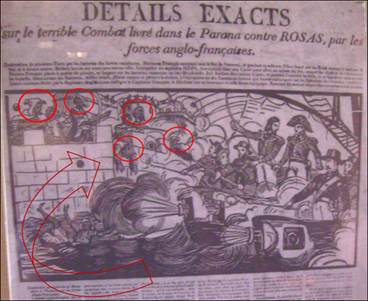
Figure 7 French newspaper from January 1846, in Catalog de l`Histoire de France, MDCCCLXI, pp. 648. Paris. The attack of a French ship on the Argentine defenses is observed. Argentines look like Arabs.
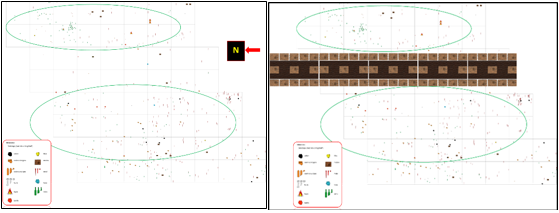
Figure 9 Excavations in the area of the first battery. At a depth of approximately 0.50 m. Two concentrations of materials are observed at the top and bottom of the plane. There remains a strip almost empty of finds. It is hypothetically proposed that in this almost empty area the merlons (wooden boxes) filled with earth would be located to fortify the place.
Case 3
Problems to be solved: ¿Do the sections of chains found correspond to the shortcut system placed in the Paraná River, near Vuelta de Obligado, in 1845?
Sources of information: 1. archaeological record, 2. written documents, 3. side scan sonar and 4. materials laboratory.
This information is summarized in Figure 10 (Figure 11, Figure 12, and Figure 13).
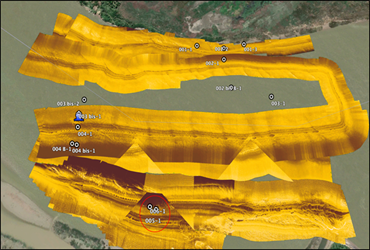
Figure 11 Bathymetric study with side scan sonar. One of the 2 points (6) of the 16 anomalies detected in the area coincide with the 2020 discovery location, the plans and several representations. Director: A. Argüeso. Team: N. Ciarlo, M. Darigo, A. Raies and M. Warr. Technicians-operators: A. Kalfayan and J. Rodríguez Saumell. February 2016.
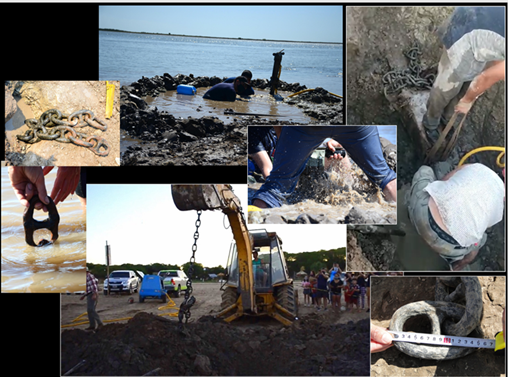
Figure 12 November 2020. Extraction of chains from the battle. Team: members of ProArHEP-UNLu-UNR-UBA and team from the Municipality of San Pedro.
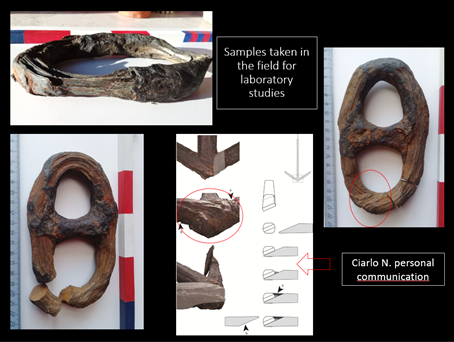
Figure 13 Samples of links analyzed by Eng. Horacio De Rosa in the laboratory of the Archaeometallurgy Group (GAM), Faculty of Engineering of the UBA. It is Fe with slag with a filamentous structure (raw material from the first decades of the 19th century). The technology for making it was by forging red-hot Fe rods. The counter was placed red-hot, under pressure and with hammer blows. There is no welding (corresponds to the first decades of the 19th century).
Discussion and synthesis: objectives, data and diagnosis
Case 1: Objective: signs of the defenses mounted in the area of the second battery. Extensive excavations in the area indicated by the written documents and representations.
Results: 1. Positive finds: archaeological objects (artifacts and structures); 2. Negative findings: 11 semicircular post imprints, 1 isolated imprint, 3 large pits and rectangular shapes on the rough slab.
Diagnosis: the findings would correspond to the palisade, bases and support of the cannons. This is the occupation floor of the second cannon battery in Vuelta de Obligado
Case 2: Objective: signs of the defenses mounted in the area of the first battery. Extensive excavations in the area indicated by the written documents and representations.
Results: 1. discovery of many fragments of artifacts that make up 2 zones in the humus layer. In the middle of them there is a space almost empty of finds. 2. Written documents mention merlons, for example, the Field Diary of the commander of the first battery.37 A French newspaper from January 1846 shows a battle scene with a battlement-type wall. The artist exaggerates the military field fortification.
Diagnosis: the spaces with artifacts and fragments would indicate areas of activity and the empty spaces in the distribution of the archaeological record would indicate the location of the merlons that did not allow the deposit of more objects. It would be the occupancy floor of the first battery in Vuelta de Obligado
Case 3: Objective: interpret two sections of chains found and their relationship with the shortcut system proposed in 1845. Rescue excavation, punctual.
Results: a single section of chains and its anchoring in a piece of wood 0.30 x 0.30 x 1.50 m deep are discovered. Written documents and representations highlight the system built in the Paraná River in 1845. 1. The side-scan sonar bathymetric study carried out in 2016 detects 16 anomalies. A detected anomaly coincides with the place of discovery and the representations (plan by Sulivan 184538 and engraving by Chavane 184739). 2. Laboratory: the raw material of Fe corresponds to the beginning of the 19th century. 3. The technology for making the links is by forging rods; without welding.
Diagnosis: it would be a section of chains and their anchoring used in the shortcut system set up between August and November 1845 in Vuelta de Obligado.40
1In addition to reflecting on the method in science, particularly on the deductive hypothetical method, Popper dealt largely and for different reasons with the methodology of social sciences as a problem with strong ideological ingredients. Thus he created papers such as The Open Society and Its Enemies, a book in which he argues logically, methodologically and philosophically about what he calls totalitarianism and against all social philosophies, which according to him can serve as a pretext to violate human rights and freedoms. There he argues against a Plato that he believes was more inspired by a militaristic, authoritarian and despotic state like Sparta than by the particular democracy of Athens that was supposed to defend human rights - although it had slaves and strong social differences - and defender of spiritual values. Popper, who was a liberal scholar, in addition to being a very intelligent epistemologist and good arguer, also wrote another book that is a great attack on social theories: The Poverty of Historicism, in which he analyzes what he calls sociological myths of a historicist nature. Although its analysis should be taken into account, it should be considered above all with respect to aspects of scientific methods in the social sciences. Thus, the existence of supposed laws that allow predictions to be made and provide grounds for rational or irrational action can be reviewed (Klimosvky and Hidalgo 1998).
2These observations, extended first to a disciple of Botticelli, Filippino Lippi, and then to the other Florentine masters, led to the same result; each artist had his own particular style for painting those details.
3Socrates, during the 5th century BC, defined mimesis as an apparent representation and questioned its sacred immanence. Plato refers to mimesis as the sensory appearance of the external images of things. This constitutes the opposite world to that of ideas and is close to the logic expressed in the Allegory of the Cave. It is an imitation of reality or a copy of the world of ideas.
4Several disciplines are involved in solving a problem.
Based on the research that we have been developing since 2000, we can make the following synthesis:
We are not so far from the procedures used by the scientific police of which characters like Sherlock Holmes were not only an inspiration as a fictional expression, but a resource used by Conan Doyle to advance an investigation process. We look for clues that allow us to get closer to the reality of the past using, in a convergent manner, different sources of information to have a more accurate version of what really happened.
I thank all the members of the Archaeology Team that I lead, made up of students and professionals from Argentine universities such as UNLu, UBA, UNR, UNLP, UNSAM and others. Also to the members of CONICET and foreign professionals (Brazil, Chile, Cuba, Colombia, etc.) who participated and participate in the investigations since 2000.
There are no conflicts of interest.

©2023 Ramos. This is an open access article distributed under the terms of the, which permits unrestricted use, distribution, and build upon your work non-commercially.